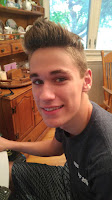The Astronaut’s Life
by
L, age 9
All astronauts train continuously for many years. Mostly the training takes place in large water tanks because the water helps astronauts adjust to being weightless. Some astronauts, who are called mission specialists, are doctors, engineers, or scientists. They learn to do special jobs in space. Although astronauts have different jobs, they all train.
After all their training astronauts are eager to get into orbit. To help boost the shuttle into space, the spaceship needs two rockets. However, when the spaceship reaches orbit the rockets strapped to it drop off because they are no longer needed. When they are going into orbit a force, which is called gravity, mightily pushes the astronauts back into their seats. Once they are in orbit, the force is gone. Now there is no gravity to hold them down. Fortunately, their training has prepared them for life in orbit.
Because there is no gravity in space, it is extremely challenging to live. Strangely, everything on the ship floats. The capable astronauts eat, sleep, and work floating. Because their food and water float, they use straws to drink. Astronauts, who have been trained for weightlessness, are strapped in bed to sleep and also sometimes while working. Although astronauts are well trained, with no gravity, living in orbit is still very difficult.
The Fascinating Airplane
by
son G, age 10
Most military aircraft, which have jet engines, are amazingly maneuverable. Incredibly, fighter planes can roll from side to side and make quick turns to attack or escape. Since fighters are light, with their powerful engines on full blast they can fly straight up. Afterburners, a part of a jet engine, give planes extra thrust so they can go faster. Military fighters are known for their maneuverability.
All planes require landing gear to land. Thankfully, the landing gear is on the end of legs which are stable. Of course, the wheels have shock absorbers. Just as it sounds, the landing gear is obviously used to land.
Inside an airliner’s fuselage, which is the largest part of the plane, is the passenger cabin. The cargo hold is under the cabin. Aboard different airliners, seats are arranged differently. Amazingly, people can breath at such high altitudes because oxygen is continually pumped through the plane in pipes. The fuselage and every part of an airplane is very fascinating.
by
Considering their small bodies, mice have an exceptionally large stomach and powerful jaw, not to mention their speed. Most rodents are herbivores. Herbivores eat mainly plants and other non-living things, but there can be an exception. Included in their diet are insects, nuts, seeds, and fruit. Surprisingly, mice eat strange things, such as wallpaper glue, tape, and soap, and actually don’t eat a lot of cheese, if any. Their daily diet would be like you having a miniature thanksgiving feast to yourself every day! All rodents have large, strong, curved teeth called incisors, which are two long front teeth in the center of each jaw. Growing non-stop, the rodent must wear its chisel like incisors down by chewing and rubbing them together. If the rodent does not do so, the top incisors could curve back and pierce its skull. Without their sharp teeth and powerful jaw, mice would not be able to chew through all the things they can, like: paper to wood and plaster walls to even sheet metal.
Because mice live out in the wild, families must depend on each other to survive. Usually, female mice have litters of 10-24 babies, or pups. Some species can have litters 3-4 times a year! That’s a lot of babies! Blinded and helpless, baby pups look up to their mother for care and protection. Leaving the den only for short periods of time if not at all, the mother gives her pups the proper care they need until they are ready to depart from the nest, which isn’t a long time to wait. Within 6 weeks the pups are grown enough to start their own family. Of course this is normal for them because mice only live 2-4 years. It is extremely dangerous, though, for a young mouse to start a family out in the wild, facing the dangers of its habitat.




8 comments:
well done all three!
I think L needs to come down here and visit Space Center Houston and tour NASA. He can bring his parents and siblings if he wants. ;-)
awesome! I dare say, probably better than my compositions in high school, and I was a straight A student! Way to go!
Just another thought, very impressed with the 9 year old's composition considering that he's been reading about 2-3 years (am I correct on that stat?)
Good job you guys!
Thanks, all, for the encouragement.
Jennifer, L has been a fluent reader for just under 2 years. He had his "I Can Read" party a little over 2 years ago and then grew in fluency as he read more and more. So, yes, a fairly young reader.
I love how IEW gives my kids the tools and confidence they need to put their thoughts coherently on paper!
Is IEW Tapestry's writing program? I'm still pretty new to Tapestry and am trying to learn all of the different aspects to it. We're not using their writing this year, but I'm considering it for next year.
Kathi,
IEW is not TOG's writing program, but it is very compatible. IEW teaches you HOW to write, TOG's writing program tells you WHAT to write about each week. Many families use them both. We are not trying to follow TOG's writing plan at the moment, preferring to solidify all the IEW writing models in our children's minds first. Once they have those down, writing on TOG topics will be pretty easy. Hope this answers your question!
I guess one other question, then...
What does IEW stand for? Do you have a link that shows info on the curriculum?
Thanks!
Kathi, IEW stands for Institute for Excellence in Writing, and the letters IEW in this blog post are a hyperlink that will take you to their website. Click on them and it should take you there!
Post a Comment